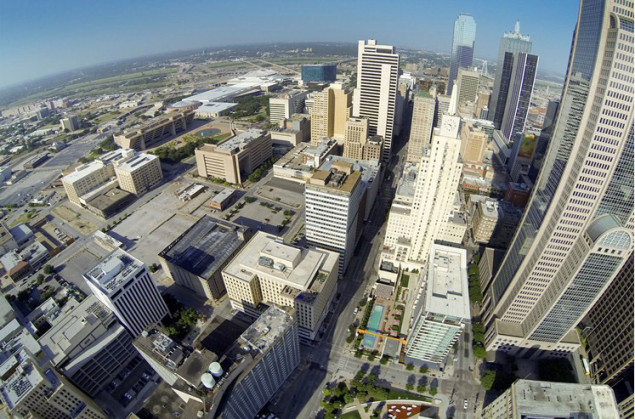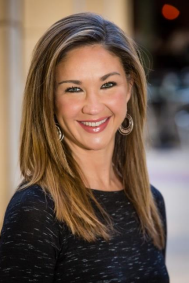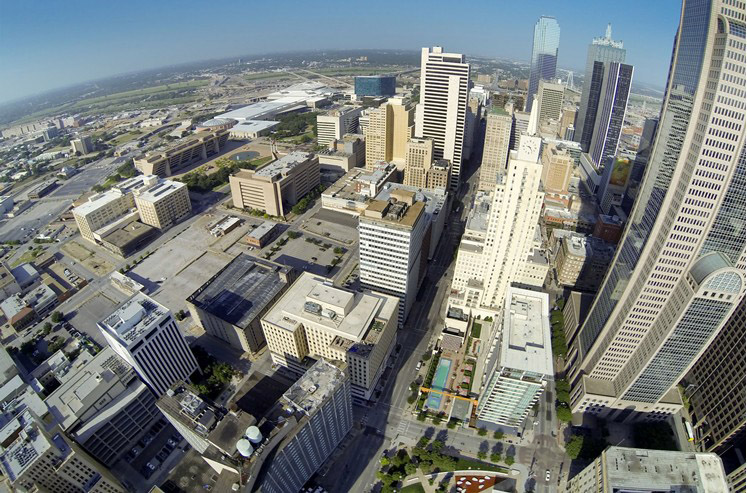
Kourtny Garrett has worked for Downtown Dallas Inc., the nonprofit that advocates for the businesses and residents of downtown and oversees programs to help keep it a clean and safe place, for more than 13 years.
In March it was announced that she has assumed the role of president of the organization and will take over as CEO come next January, when current chief executive John Crawford transitions into a new role as vice chairman.
After a recent visit to the Dallas Farmers Market blew my mind about how great that corner of the central business district is becoming, I asked Garrett to have a conversation (via instant message) about her unique vision for the future of DDI and the neighborhood. I share that with you now.
Jason Heid: Congratulations on the new job, first of all. I assume it’s your dream job, and you’ve accomplished all of your life’s goals now?
Kourtny Garrett: Thank you! And funny. Yes, this is certainly my “dream job.” I’m a city girl and still can’t believe I make a living doing this.
Jason Heid: What is it that gets you excited about the work?

Jason Heid: What do we want it to be?
Kourtny Garrett: What we’re hearing is a paradigmatic shift in Dallas. That may sound like an overstatement, but if you think about the now-mainstream use of terms like “walkability,” “TOD,” urban greenspace, etc., you realize that compared to even a decade ago this is a new language in our city.
Jason Heid: Walkability is bound to come about as the city gets denser, isn’t it? Isn’t the problem that we’re so spread out?
Kourtny Garrett: Walkability is certainly a part of the evolution of redevelopment, which you’re right, has a tremendous amount to do with infill development. I’d argue that it’s not so much about the distance between places, though, but the gaps in between them that are a greater barrier. Now that our adaptive reuse phase of development is nearing complete, you’ll see more of that infill coming. And if we couple that with beautification and activation improvements, then you really start to get somewhere.
Jason Heid: So you must be in favor of tearing out Interstate 345 and uniting the CBD with Deep Ellum?
Kourtny Garrett: DDI’s leadership has been supportive of TxDOT’s CityMAP study, based on what we know of successes with either tear outs or reconfigurations in other major cities (Boston, San Fran, etc). That said, we’re also not traffic engineers, so we’ve supported the CityMAP effort from day one as it is expected to present scenarios that are grounded in local conditions. Personally, I walk between the Farmers Market where I live and Deep Ellum regularly, so I’d say with that SOMETHING has to be done…
Jason Heid: Ah, good. You followed the politician’s answer with the answer of a resident.
Kourtny Garrett: That’s why they gave me the job, right?
Jason Heid: So Downtown Dallas Inc. defines downtown Dallas differently than I might. When you say downtown, what extent of area do you mean?
Kourtny Garrett: When I talk about Downtown, I’m generally referring to a “greater Downtown area,” based on our 360 plan. When we assembled the first gen of the plan in 2010-2011, it was based on the vision for a symbiotic urban core comprised of many districts — each with unique attributes and experiences, but a part of a greater urban whole. So I break the greater Downtown into those districts quite a bit.
Jason Heid: And those districts don’t have contradictory goals?
Kourtny Garrett: You can find inherent contradiction in just about every aspect of urban development. Again, the complexity is what makes a true “city.” However, that issue was a significant reason for articulating the area as districts and beginning to define their character. For example, the retail targets for Main Street are different from what you want in Deep Ellum, which is different from the Arts District or Victory Park.
Jason Heid: And how does Downtown Dallas Inc. help those targets to be reached?
Kourtny Garrett: From a strategic standpoint, I’d say by facilitating the vision. Mind you, it’s not about DDI’s vision, but about supporting neighborhood interests. We then help to vocalize that vision, and after more than 50 years of building partnerships between the public and private sectors, we get down to the tactical level to implement.
Jason Heid: Why does downtown Dallas matter? Is it any more important than any other neighborhood of Dallas?
Kourtny Garrett: The answer you surely expect me to give includes the size of our tax base or that we have 135,000 employees and virtually the only growing residential population in the city of Dallas. That if the heart of the city is decaying than the rest of the city can’t be successful. And all of that is true. But I firmly believe that we can’t continue to have this “Downtown or the rest of city” conversation. It has to be about the city as a whole.
Jason Heid: Was downtown Dallas decaying?
Kourtny Garrett: When I started [with Downtown Dallas Inc.] in 2002, we had just begun to plant the seeds of recovery from the decline that began in the late ‘80s.
Jason Heid: Things were bad?
Kourtny Garrett: Surely you’ve heard the tumbleweed legend? Or “you could shoot a cannon down Main Street without hitting anyone!”
Jason Heid: Seems that way, outside of lunchtime sometimes. Not as much as it used to.
Kourtny Garrett: Exactly, “not as much as it used to” is the key phrase. Keep in mind all of what you see today has really just happened in the last decade. The first TIF was created in the CBD in the late 1990s. Uptown’s wasn’t much earlier. There were 200 residents in the CBD in 1996, now we have almost 10,000. We had 30+ vacant buildings, now all are activated or in play. The list goes on … Again, evolution.
Jason Heid: What’s the biggest stumbling block still facing downtown?
Kourtny Garrett: I think we want to be mindful of the market and where we are in development cycles. Fortunately Dallas hasn’t historically experienced the peaks and valleys of other markets, but we’re still sensitive to getting overly aggressive in the “good times.” Similarly, we’re talking quite a bit now about the cautionary tale we see in other cities about out-pricing the workforce and middle class in our housing market.
Jason Heid: Is it a pipe dream to think downtown, particularly the CBD, will ever have a decent mix of affordable and luxury housing, given how prime the real estate is?
Kourtny Garrett: Today you can still find it. My kiddos’ nanny lives at Lone Star Lofts, and when I sold my loft in the Cedars last year it was still less than $90/sf sale price. Conversely, my townhome in the Farmers Market has appreciated 20% every year for the last four years. There are some interesting programs emerging in cities like Denver — who are recognizing that prices have gone too far — so we’re working with groups like The Real Estate Council and the city’s affordable housing task force to hopefully have a proactive solution before we reach a critical San Fran-ish point.
Jason Heid: Let’s hope we never get there.
Kourtny Garrett: Agree. I need more neighbors.
Jason Heid: And a grocery store?
Kourtny Garrett: My favorite question
Jason Heid: Ha, I bet.
Kourtny Garrett: The Dallas Farmers Market! Seriously, I do 90% of my grocery shopping there now. And the new Whole Foods on McKinney. And soon the Kroger on Ross and Tom Thumb at The Union [a building redevelopment in Uptown].
Jason Heid: OK, OK, I know, I know
Kourtny Garrett: But yes, I think there are more names, as well as bodega-style markets, coming sooner rather than later in probably how you define Downtown.
Jason Heid: What’s the magic number of residents? The number that’ll get a bodega on every corner?
Kourtny Garrett: Back when I started there was a “they say” answer of 10,000. If true, then we’re just about there, which is probably why my phone has been more active with this conversation recently. But it’s also more complex than that. Since we’re dealing with mostly adaptive reuse projects, you have to find a space with just the right bones to handle a grocer-type operation, which isn’t as easy as you’d think. That said, bring it, and we’ll make it happen.
Jason Heid: Enough about the obstacles. Let’s talk about what’s great about downtown. Would you live downtown even if it weren’t in your business interests to do so? Why?
Kourtny Garrett: I really would. My husband and I lived in a four-plex at Fitzhugh and Munger while I was still at Children’s [Hospital], and we moved to the Cedars very shortly after I took this job, thinking it was only an 18-month contract. Like I said, really, simply I’m just a city girl. I love to live life outside of the walls of my house. To walk to dinner and run into friends, colleagues, business acquaintances. To always have something “to do” — an event, a park, a museum, or just an interesting walk. I love the historic buildings, the diversity and authenticity … OK, you probably get it by now.
And I could never be trusted to keep up with a yard.
Jason Heid: What’s your favorite spot in downtown?
Kourtny Garrett: I love and hate that question. Since I live across the street, and you’ll literally find me there about every other day at some point, right now it’s the Dallas Farmers Market. But my kids use Main Street Garden as their backyard. They call it “Mommy’s park.”
Jason Heid: That’s nice. It’s like a yard you don’t have to maintain
Kourtny Garrett: EXACTLY
Jason Heid: I know you’re not out to undo the work of your predecessor, but what do you think your own unique stamp on doing the job is going to be? Your own special priorities?
Kourtny Garrett: That’s a good way to put it because John and I have worked together for so long that “my” vision is really a part of what we do every day. That said, I’ve been a student of urban management for my entire career, so I’m probably more focused on programmatic and pragmatic quality-of-place and quality-of life solutions — the “on the ground” stuff. I assume that’s a large reason I was chosen to follow him: That Downtown is to the point where a lot of the big political and economic development moves created this momentum, and now it’s time to take that success and connect it, make it livable and create a complete neighborhood.
Jason Heid: Can you give me a concrete example?
Kourtny Garrett: So, with mobility, think cycling infrastructure, bike share, designing “great” multi-modal streets. When I think of “livability,” it’s supporting a growing residential base with adding services (like the bodega) and amenities. And education. Education is a huge priority — to have more quality schools, particularly pre-K thru high school.
And always our first priority is on “clean and safe.”
Jason Heid: But what can you do to facilitate improvements in the schools?
Kourtny Garrett: I’ve been working with DISD for a couple of years with particular focus on the Choice/Innovation and Transformation school models. Our strategy is brick and mortar — I need supply. ASAP. If you look at an elementary map, for example, there is an obvious void. And in, as I said earlier, the fastest growing residential population in Dallas. These innovation and transformation schools can be very entrepreneurial, leaving opportunity to build public-private partnerships to get schools on the ground. Immediately, though, we’ve just been successful with redrawing the boundaries for Milam Elementary in Uptown, so most of our “Downtown” parents can send kids there, and there is interest in doing the same at Sam Houston.
Jason Heid: Interesting. So how long until we’re saying “Downtown is the new Uptown,” the place where all the cool kids want to be?
Kourtny Garrett: To your earlier point: Main Street, the Arts District, West End, Farmers Market, etc., will never be “Uptown,” nor should they. But I’d say we’re already where the cool kids want to be. And in two more years at this trajectory … THAT gets me excited.






